Why do certain pans capture the imagination?
VFC says: This guest post was contributed by reader Martin.
Curiosity
There are pans in a kitchen that are more useful than this small saucepan. Measuring 10cm by 8cm (3.9 by 3.1 inches), it could serve as a butter pan or be used to prepare and serve small nibbles. But those were not the thoughts that moved me to buy this little one. Rather, it was the stamps that immediately caught my eye when I saw what was on offer. In particular, a crown and four letters piqued my curiosity. But I was also interested in the stamp of a manufacturer I had never heard of before.
Even without further research, it was obvious that the small saucepan would have to be an English product. The design of the cast iron handle with the triangular support plate, as well as the suspension eye in the form of a simple keyhole gave the first clues (although some narrow French pans were also equipped with similar handles). A second look was directed at some still slightly silvery spots in an area about 2cm below the outer rim of the pan. It quickly became clear that these must be remnants of tinning, typical of many English pans. I don’t know why British manufacturers put these tinned “bands” about 2-5cm wide, depending on the size of a pan/pot, on the outer rim of the pan. What practical advantage did they offer or was it purely decoration? British VFC readers will certainly know.
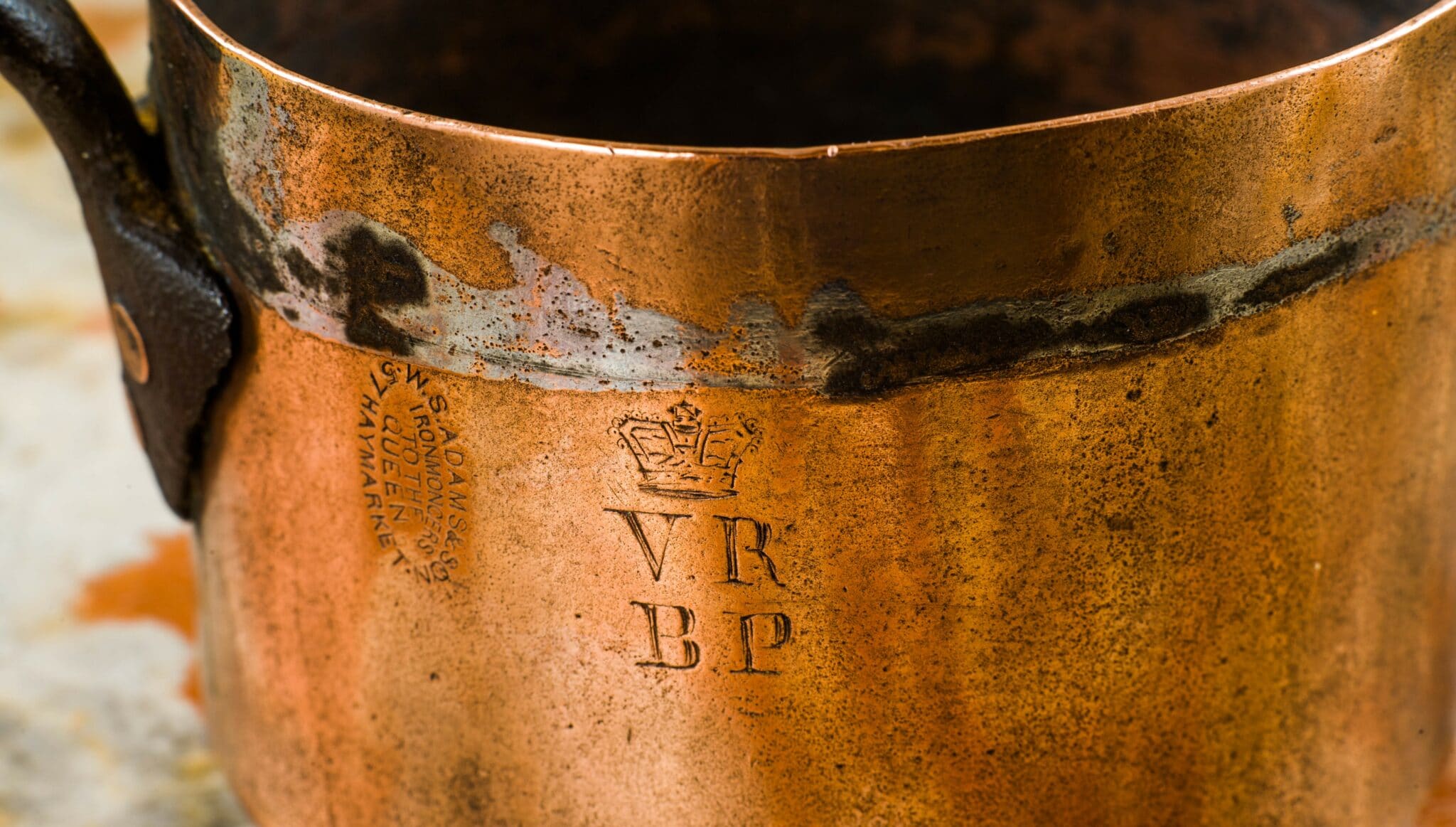
The small saucepan is a flyweight. It weighs only 473g (1 lb) and is thus the record holder at the lower end of the weight scale of my collection. Most of my lids weigh more. The copper, which is only about 1.5mm thin, the handcrafted production by means of dovetails and the other features suggest manufacture from about the mid 19th century.
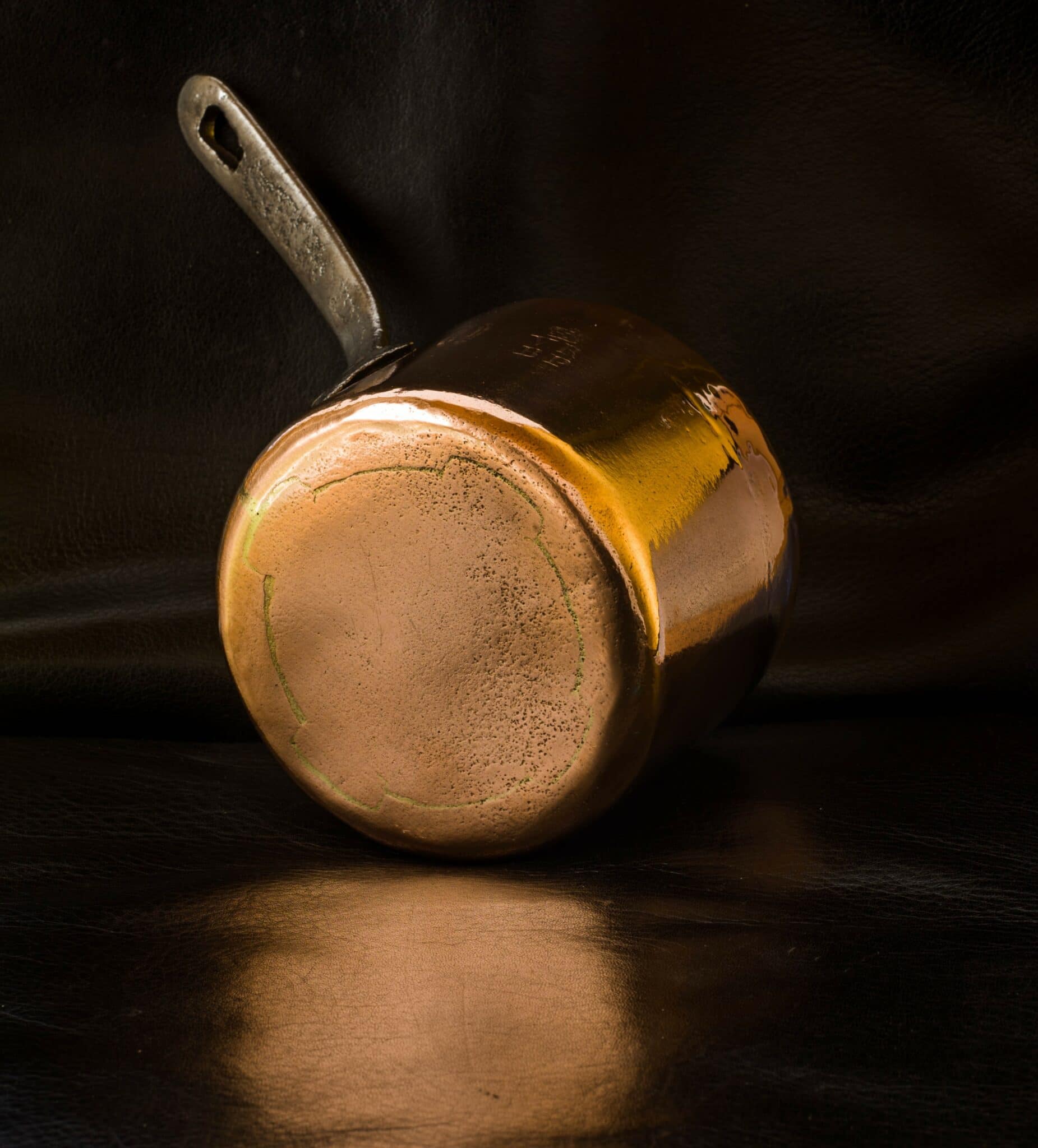
The maker’s stamp not only confirmed my suspicion, but increased my research interest. After all, between the name “W.S. ADAMS & SON” and the address “57 HAYMARKET”, it also reads “IRONMONGERS TO THE QUEEN”.
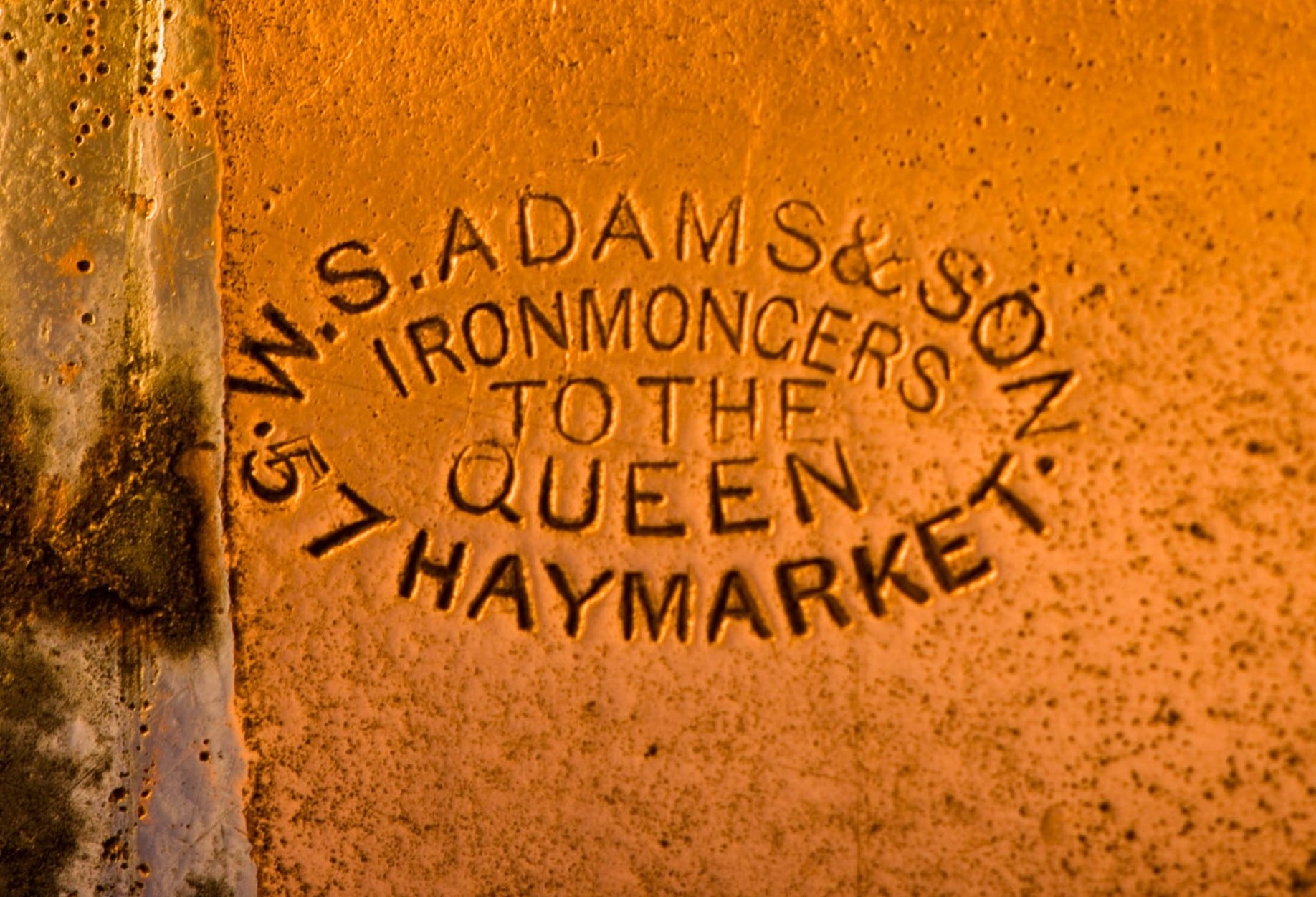
Immediately my view changed again to the five stamps — a crown, under it first the letters “VR” and still one line lower “BP” — directly beside the manufacturer’s postmark. First ideas whirred through my head. So on to the Internet! But first I would like to describe the condition of the small saucepan.
External condition
It is not unusual for old pans to have a variety of scuffs, scratches and sometimes dents. Many of us even appreciate these signs of an intense working life in a kitchen. But if a pan is littered with hundreds of small holes, then these are not “badges of honor” of a long working life, but probably signs of neglect.

Pitting is the name given to this kind of corrosion. A really nasty thing that is hard to deal with. My little saucepan was attacked by this disease. Neither the photos of the selle, nor the description gave reason for such a presumption. I could only see that the pan was heavily corroded and therefore very dark on the outside and inside. Only after I had thoroughly cleaned the pan did this unpleasant surprise come to light. But my doubts about the purchase did not last, especially since the price was low. However, the uncertainty remained for a while whether a restoration really made sense.
The Manufacturer
William Salkeld Adams (1808-1898) is listed in London trade directories, electoral registers, and rate books as an ironmonger located at 57 Haymarket from 1839-80. The Adams premises at 14 Norris Street were first listed in the tariff books in 1856. I found another entry for “ADAMS, W.S. & SON” in Debrett’s Illustrated Peerage and Baronetage of the United Kingdom of Great Britain and Ireland, 1862 (shown at right). In this standard work of several hundred pages, one finds the entire hierarchy of the British nobility with all ramifications listed in an extremely detailed manner. At the end of the book follow the court suppliers, differentiated according to categories of goods or occupational titles. In this volume of 1862, both addresses mentioned above are listed. If you want to study the British nobility in more detail, I can recommend a study of the work of Debrett. One finds it under the mentioned title in the Internet.
Crown and monogram
My research showed that the crown stands for a king or queen. Even if the stamp is already rubbed off, the characteristic features like orb with cross, the jewels framing the crown and the lower widening, which in the original is made of ermine fur as padding, can be recognized with sufficient certainty. See comparison images to my photos.
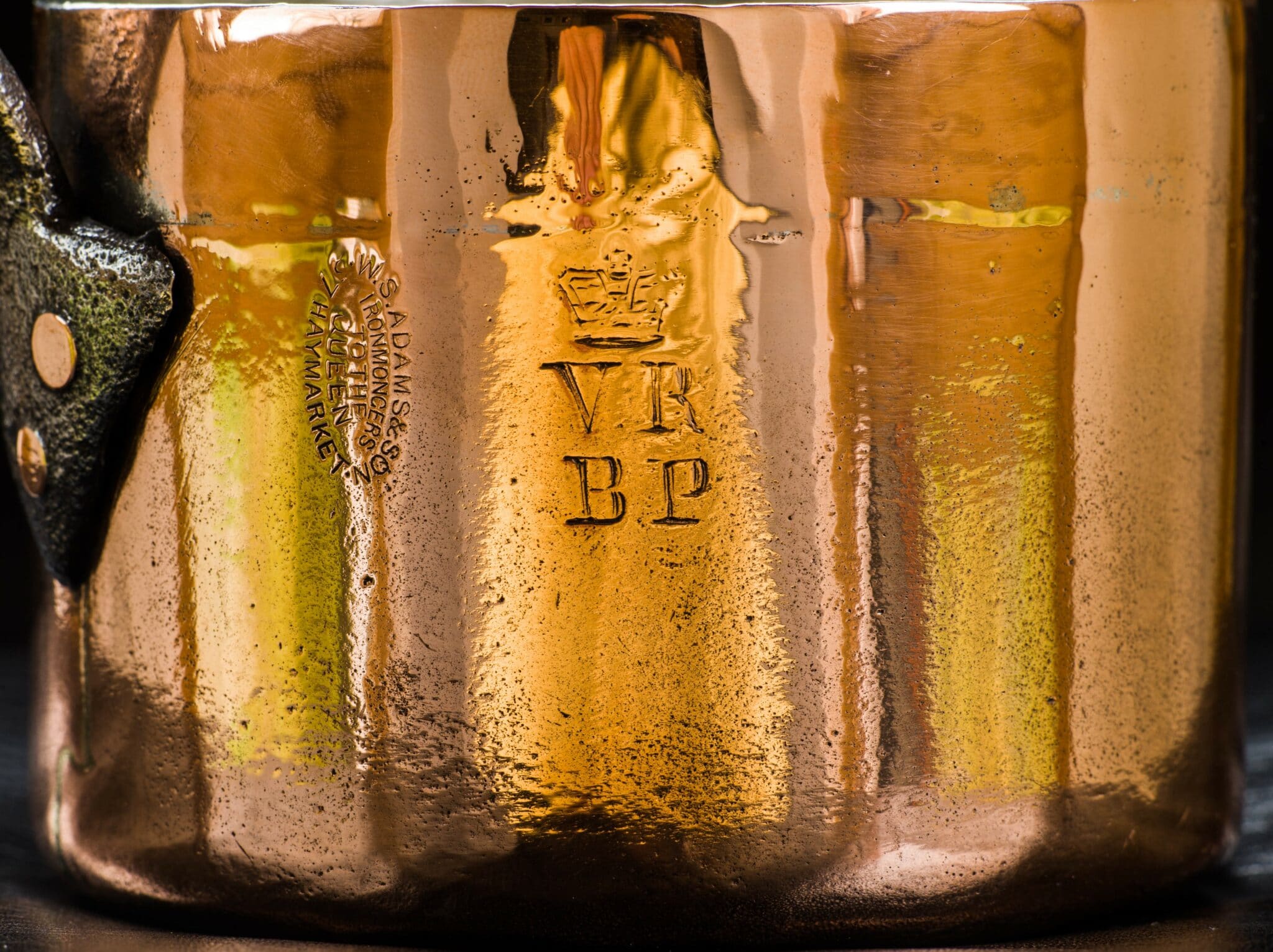
Based on the royal crown, it was not difficult to interpret “VR” as VICTORIA REGINA. The comparison images of Queen Victoria’s monogram prove this. As the royal head of Great Britain and Ireland, Queen Victoria reigned from 1837 to 1901. She was also the first Empress of India.
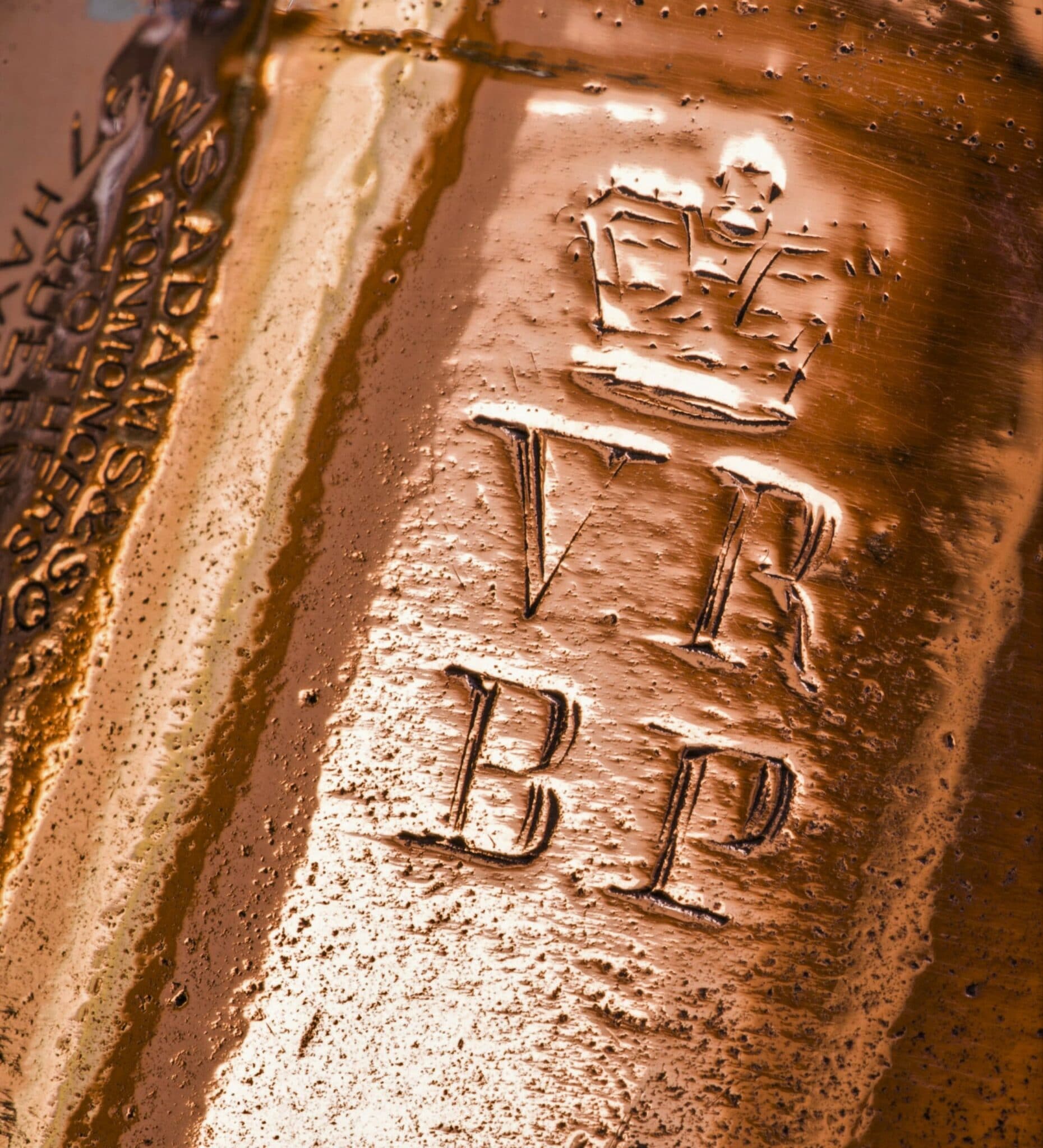
But what does “BP” stand for? Since the inventory of the royal palaces was systematically recorded from the stationery with letterhead to the furnishings of the kitchen and dining rooms, my first guess was “BP” stands for “BUCKINGHAM PALACE”. However, on comparison pictures of I found no abbreviations, but always the full name of the palace. Then I had the thought “BP” could mean “BRITISH PEERAGE”. I would be glad if readers could clarify this point.
Concluding remarks
Whenever I discover an interesting piece of historical kitchen copper, I go through some time in euphoria, of course, it does not last. But what remains over time is a kind of good friendship. So it will be with this, my smallest saucepan.

Meanwhile, she returned to my kitchen after her renovation at Atelier du Cuivre, Villedieu-les-Poêles. Unfortunately, the craftsman was not able to reattach the tinned strip on the top edge. Now, while it does not perfectly match the design often found on English pans, it is otherwise perfectly renovated and sparkles like a little star in my kitchen.
VFC says: Martin, what a delightful piece this is! I understand completely how it captivated your imagination. I am glad the restoration turned out as beautifully as it did.
As for the BP mark, my vote is that it is indeed the designation for Buckingham Palace. I know from experience the temptation to link a set of stamped initials to the most exciting personage possible, but in this case the simplest explanation seems to me to be the most likely. I would expect there were many such pieces in existence at one point — perhaps more have survived to the present day. Readers, have you seen more pieces with these same markings?
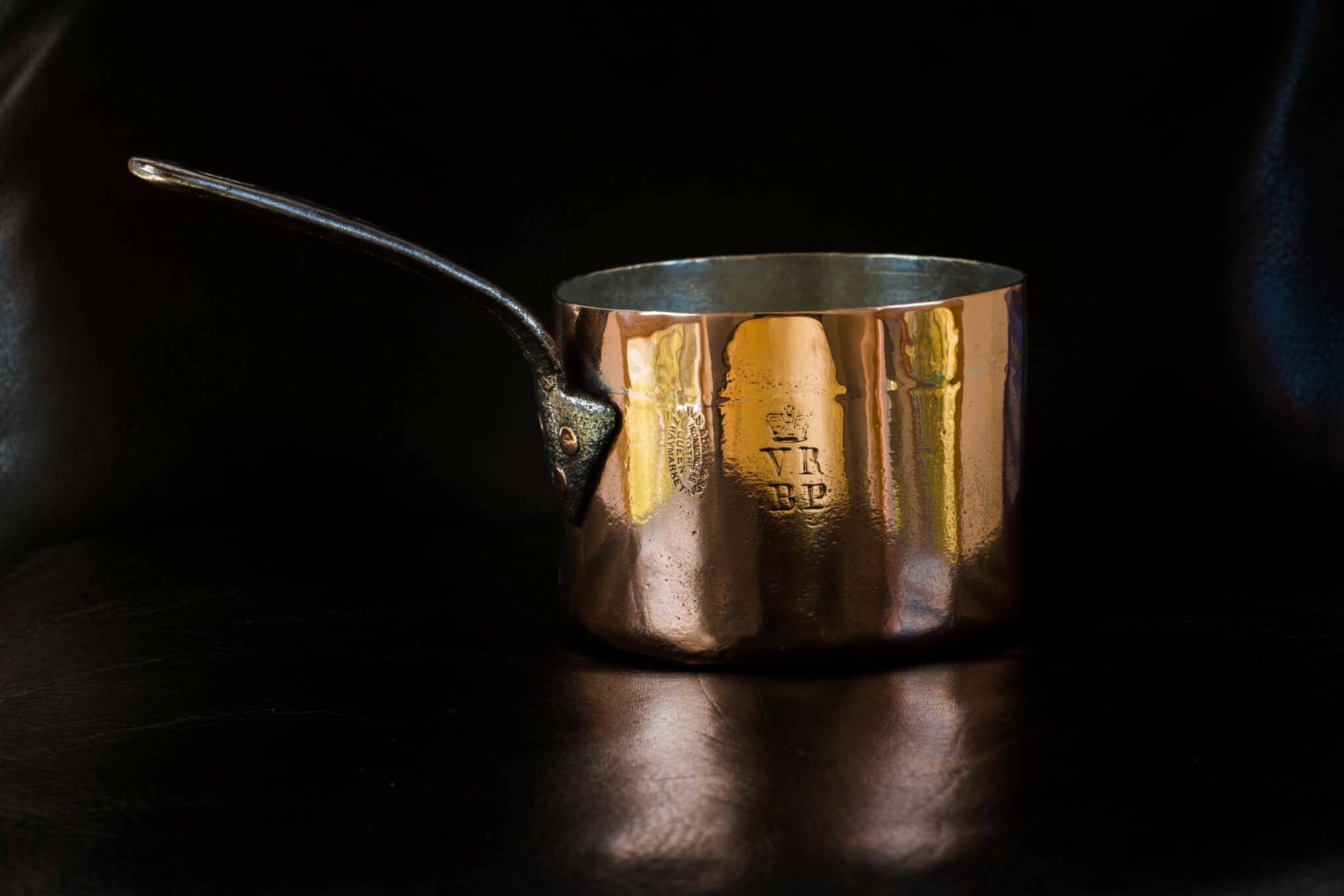






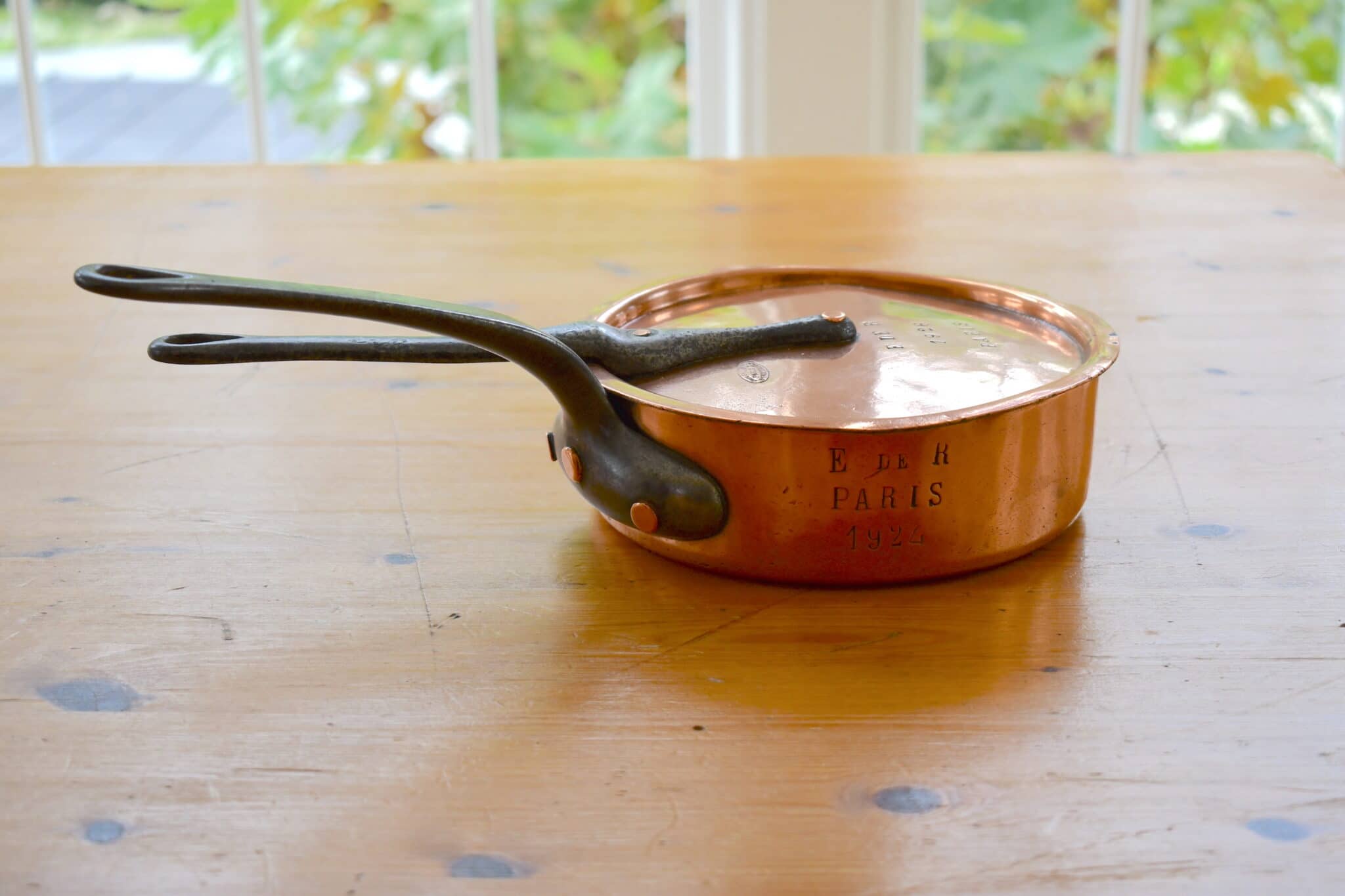
It’s a beautiful piece. It has the same marking as my VR kettle from Buckingham Palace. Mine doesn’t have the coronet, but it has the year and position number for its place in the kitchen. I love hunting for all copper, but when you find the ones you can tie to certain place, it makes the find even better.
Thanks for sharing! What a joy to be able to relish in other peoples copper delights as well.
Cam, I feel the same way when I follow the posts on VFC.
Shared joy is double joy.
Chris, I agree with you. A pan whose exact home can be determined, based on which you can feel the atmosphere of that kitchen and let your imagination run wild, has its own special appeal.
Unfortunately, it was not possible to include my references of the noble origin of the pan in my post. I hope, even without further examples of Queen Victoria’s monogram and crown and other evidence from Buckingham Palace, its origin is plausible.
Martin, I would be almost certain that is from Queen Victoria’s Buckingham Palace kitchen. The person who validated mine is the tinsmith I’ve had a lot of my copper restored through. He’s also the royal warrant holder for the royal family and does all of their copper. He’s restored a lot of Queen Victoria’s cookware still in use in the Royal household so that’s about the best validation I can imagine I’d be able to get.
Through some online searching of my own I was able to find a few photos of Queen Victoria’s monogram and coronet, so it looks like you have the real deal.
Congrats on a beautiful piece and a wonderful piece of history.
Congratulations on the validation of your pans by the royal tinsmith (I think I read about him). Appraisal can not be more serious. This also gives my little Victoria a confirmation of its authenticity. Thank you very much!
By the way, I discovered this saucepan at a junk dealer (secon-dand-dealer) in Spain. There I also found an interesting saucepan by Paul Manzoni, Switzerland. It’s amazing how far some pans travel and in what inconspicuous places they turn up. Similar sources become all the more important to me as others are already too well known.
Glad I could help. That’s amazing that you found that at a junk dealer. It’s crazy how these things end up where they do. If only they could talk. I actually found mine on eBay being sold by a charity shop. I was the only one who bid and didn’t realize what I had (or what I thought I had) until I received it and put two and two together.
I probably know this charity store. Didn’t he recently offer lids from Adams & Son? I wondered several times about the relatively small number of bids that came in there even with other offers. Since the Brexit, however, I always have to think of the additional duty on the prices.
I didn’t see that. After I bought this piece I went backed and looked through the store more carefully. There was no other copper.
Brexit has gotten me too. There have been a lot of pieces I would have bought from France if not for the increased shipping costs and taxes.
There are probably several such charity stores on eBay. The last one I saw used the proceeds to benefit a children’s hospital in Yorkshire.
Both sides of the channel now have disadvantages. There are also other bureaucratic obstacles. For example, recently a seller on Etsy, much appreciated by us copper friends, no longer ships to other EU countries. A new EU packaging regulation for environmentally friendly disposal requires an elaborate registration and brings additional costs. Thus, Etsy is now only a pure source of information for me. Perhaps this makes it even more understandable why I look for alternative sources of supply.
What a treasure and thank you for sharing the identification of more royal copper! I know that the starting condition was pretty rough, but I was saddened to see that the tin band and some of the detail in the coronet have been polished away. I enjoyed seeing the before pictures.
Valerie, unfortunately, it is as you write. I had long thought about whether to restore the pan at all. In addition, I always ask the craftsmen to preserve the authenticity to the maximum and, in particular, to take the utmost care with the stamps. But you yourself know best that this is difficult. On the one hand, the pan has benefited from the restoration, but on the other hand, it has also suffered. The little one has certainly also shed a few tears.
Great post, Martin, with exceptional photographs as well! I’m not familiar with the BP stamp, but I understand the euphoria you describe. I really hope this wonderful little pan lived part of its life in Buckingham Palace! It’s a lovely historical gem. Thanks for sharing!
Thank you Amy! By now I’m almost certain that the little saucpan was part of the equipment in the kitchen at Buckingham Palace. There was never any doubt about the stamped monogram of Queen Victoria and her crown anyway. Enjoy your beautiful collection!
Hello again, what a wonderful pan!
I agree with the above, BP must surely stand for Buckingham Palace.
In other news, I have a similar age pan which has returned from Newlyn Tinning complete with restored tin band around the outside top! Do you want to see a photograph?
Hello Theo, thank you very much for your comment. Unfortunately, I have seen it only now. I know Steven from Newlyn Tinning very well. He has re-tinned many of my pans. However, since Brexit and the associated tariffs, this work has become too expensive for me as an EU citizen. If at any time you read my message, please send photos of your pan to mycoppercabana X gmail X com. Thank you! Martin